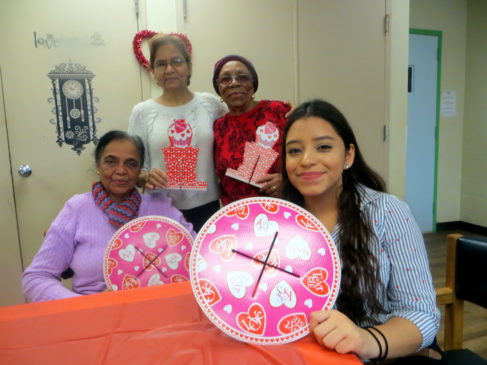
[slideshow_deploy id=’899′]
BY HILLARY VIDERS
SPECIAL TO NORTHERN VALLEY PRESS
Englewood, New Jersey — Valentine’s Day is synonymous with romantic dinners, boxes of chocolate, flowers and jewelry, and these treats don’t come cheap. A survey from the National Retail Federation estimated that U.S. consumers spent a total of $18.2 billion on their valentines this year. Over $4 billion of that was spent on jewelry alone, with another $2 billion on flowers and cards.
But Valentine’s Day is not just about spending money; it’s also about spending time with people you care about. At the Bergen Family Center in Englewood, on this Valentine’s Day, there was a heartfelt celebration for young and old.
On Feb. 14, the Bergen Family Center was festooned with valentine cards, red and pink garlands and balloons, and heart shaped candies and cookies.
The children in the spacious upstairs classrooms made greeting cards for the seniors at the Adult Day Care Center.
Darlene Tomlinson’s fourth grade class was dressed for the occasion in red and pink outfits, and she herself wore a crimson velvet gown and a tiara. “I’m the queen of valentines,” she declared, “and I’m loving it!”
Downstairs, in the senior center, members of the Rotary Club Band entertained with love songs. Bergen Family Center CEO and president, Mitch Schonfeld, played violin, Victoria Brown played trumpet and Jennie Katsaros played piano. The trio performed favorites, such as “All You Need is Love” and “And I Love Her” by The Beatles, “Moon River” and “Salut d’Amour.”
After the concert, Samantha Koppelman, a center volunteer from Guttenberg, gave out large heart-shaped cookies and dozens of toppings that she had brought from home. She supervised the seniors as they decorated their cookies with pink and red icing, sprinkles, and assorted miniature candies.
“I bake the cookies from scratch, using only natural ingredients and no additives,” Koppelman said. “Just flour, butter, sugar, vanilla and baking soda.”
The decorating spree produced an array of delectable and colorful cookies that the seniors put into red cellophane bags to take home.
In the early afternoon, the senior festivities continued, including making Valentine’s Day cards and dancing.
Schonfeld was pleased with all the aspects of the celebration and said, “Tomorrow the band starts practicing the songs that we will be playing here for St. Patrick’s Day.”

The history of Valentine’s Day
Historians trace the origin of Valentine’s Day to the ancient Roman Empire. It is said that in the eighth century BC, people observed a holiday on Feb. 14 to honor Juno, the queen of Roman gods and goddesses and the goddess of women and marriage.
On the following day, Feb. 15, there took place a fertility festival called Feast of Lupercalia. This festival honored the gods Lupercus and Faunus, the Roman god of Agriculture, besides the legendary founders of Rome, Remus and Romulus.
On the eve of the Feast of Lupercalia, young boys and girls were brought together. The names of young Roman girls were written on a slip of paper and placed into jars and each young man drew out a girl’s name from the jar and was paired with the girl for the duration of Lupercalia. Some couples remained together for the entire year, and in some instances, couples would fall in love and marry. The custom lasted for a long time until people felt that it was un-Christian and that mates should be chosen by sight and not by chance.
The custom of pairing young boys and girls set the mood of the Valentine’s Day Festival as it’s known today. But it was actually due to the efforts and daring of a priest, St. Valentine, that the festival got its name and meaning. The story goes that during the reign of Emperor Claudius II, Rome was involved in several bloody and unpopular campaigns. Claudius found it tough to get soldiers, and felt the reason men did not join the army was because they did not wish to leave their wives and families. As a result, Claudius cancelled all marriages and engagements in Rome.
A Roman priest, Valentine, defied Claudius’ unjustified order and secretly married couples. When his defiance was discovered, Valentine was brutally beaten and put to death on Feb. 14, in 270 AD. After his death Valentine was named a saint.
According to a popular legend, while in prison, Valentine fell in love with the jailer’s daughter who visited him during his confinement. Before his death, Valentine wrote a farewell letter to his sweetheart from the jail and signed it “From your Valentine.” This expression became quite popular amongst lovers, and is still very much in fashion.
When Christianity spread through Rome, the priests moved Lupercalia from Feb. 15 to Feb. 14. Around 498 AD, Pope Gelasius declared Feb. 14 Valentine’s Day to honor Valentine as a martyr. In the Middle Ages, Valentine became known as a heroic and romantic figure, and as the patron saint of lovers.
As the notion of Valentine’s Day grew in popularity, on Feb. 14, lovers began to send love notes, called “valentines.” Exchanging Valentine’s Day cards is now done in countries all around the world.
At the party at the Bergen Family Center, amongst the myriad of activities, children as well as seniors made valentine cards, echoing the rich history surrounding the holiday. Even without spending a lot of money on elaborate gifts, the universal sentiment of expressing love is still the heart of St. Valentine’s Day.
Photos by Hillary Viders
[slideshow_deploy id=’899′]
